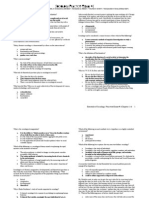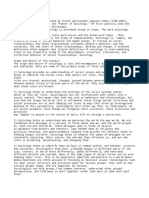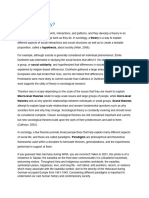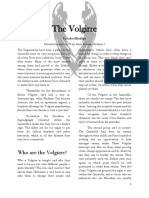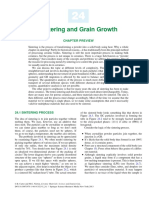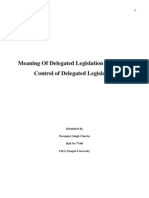Module 2 What Is Sociology
Module 2 What Is Sociology
Uploaded by
Armee B. MananesCopyright:
Available Formats
Module 2 What Is Sociology
Module 2 What Is Sociology
Uploaded by
Armee B. MananesOriginal Title
Copyright
Available Formats
Share this document
Did you find this document useful?
Is this content inappropriate?
Copyright:
Available Formats
Module 2 What Is Sociology
Module 2 What Is Sociology
Uploaded by
Armee B. MananesCopyright:
Available Formats
MODULE 2: WHAT IS SOCIOLOGY?
Chapter 1. An Introduction to Sociology
Figure 1. 1. Sociologists study how society affects people and how people affect
society. How does being in a crowd affect people’s behaviour?
Introduction to Sociology
Concerts, sports games, and political rallies can have very
large crowds. When you attend one of these events, you
may know only the people you came with. Yet you may
experience a feeling of connection to the group. You are
one of the crowd. You cheer and applaud when everyone
else does. You boo and yell alongside them. You move out
of the way when someone needs to get by, and you say
“excuse me” when you need to leave. You know how to
behave in this kind of crowd.
It can be a very different experience if you are travelling
in a foreign country and find yourself in a crowd moving
down the street. You may have trouble figuring out what
is happening. Is the crowd just the usual morning rush, or
is it a political protest of some kind? Perhaps there was
some sort of accident or disaster. Is it safe in this crowd,
or should you try to extract yourself? How can you find
out what is going on? Although you are in it, you may not
feel like you are part of this crowd. You may not know
what to do or how to behave.
Even within one type of crowd, different groups exist and
different behaviours are on display. At a rock concert, for
example, some may enjoy singing along, others may
prefer to sit and observe, while still others may join in a
mosh pit or try crowd surfing. On February 28, 2010,
Sydney Crosby scored the winning goal against the United
States team in the gold medal hockey game at the
Vancouver Winter Olympics. Two hundred thousand
jubilant people filled the streets of downtown Vancouver
to celebrate and cap off two weeks of uncharacteristically
vibrant, joyful street life in Vancouver. Just over a year
later, on June 15, 2011, the Vancouver Canucks lost the
seventh hockey game of the Stanley Cup finals against the
Boston Bruins. One hundred thousand people had been
watching the game on outdoor screens. Eventually
155,000 people filled the downtown streets. Rioting and
looting led to hundreds of injuries, burnt cars, trashed
storefronts and property damage totaling an estimated
$4.2 million. Why was the crowd response to the two
events so different?
Figure 1.2. People’s
experiences of the post-Stanley Cup riot in Vancouver
were very different. (Photo courtesy of Pasquale
Borriello/flickr)
A key insight of sociology is that the simple fact of being
in a group changes your behaviour. The group is a
phenomenon that is more than the sum of its parts. Why
do we feel and act differently in different types of social
situations? Why might people of a single group exhibit
different behaviours in the same situation? Why might
people acting similarly not feel connected to others
exhibiting the same behaviour? These are some of the
many questions sociologists ask as they study people and
societies.
1.1. What Is Sociology?
Figure 1.3.
Sociologists learn about society as a whole while studying
one-to-one and group interactions. (Photo courtesy of
Robert S. Donovan/flickr)
A dictionary defines sociology as the systematic study of
society and social interaction. The word “sociology” is
derived from the Latin word socius (companion) and the
Greek word logos (speech or reason), which together
mean “reasoned speech about companionship”. How can
the experience of companionship or togetherness be put
into words or explained? While this is a starting point for
the discipline, sociology is actually much more complex. It
uses many different methods to study a wide range of
subject matter and to apply these studies to the real
world.
The sociologist Dorothy Smith (1926 – )
defines the social as the “ongoing concerting and
coordinating of individuals’ activities” (Smith 1999).
Sociology is the systematic study of all those aspects of
life designated by the adjective “social.” These aspects of
social life never simply occur; they are organized
processes. They can be the briefest of everyday
interactions—moving to the right to let someone pass on a
busy sidewalk, for example—or the largest and most
enduring interactions—such as the billions of daily
exchanges that constitute the circuits of global capitalism.
If there are at least two people involved, even in the
seclusion of one’s mind, then there is a social interaction
that entails the “ongoing concerting and coordinating of
activities.” Why does the person move to the right on the
sidewalk? What collective process lead to the decision that
moving to the right rather than the left is normal? Think
about the T-shirts in your drawer at home. What are the
sequences of linkages and social relationships that link the
T-shirts in your chest of drawers to the dangerous and
hyper-exploitive garment factories in rural China or
Bangladesh? These are the type of questions that point to
the unique domain and puzzles of the social that sociology
seeks to explore and understand.
What Are Society and Culture?
Sociologists study all aspects and levels of society.
A society is a group of people whose members interact,
reside in a definable area, and share a culture.
A culture includes the group’s shared practices, values,
beliefs, norms and artifacts. One sociologist might analyze
video of people from different societies as they carry on
everyday conversations to study the rules of polite
conversation from different world cultures. Another
sociologist might interview a representative sample of
people to see how email and instant messaging have
changed the way organizations run. Yet another
sociologist might study how migration determined the way
in which language spread and changed over time. A fourth
sociologist might study the history of international
agencies like the United Nations or the International
Monetary Fund to examine how the globe became divided
into a First World and a Third World after the end of the
colonial era.
These examples illustrate the ways society and culture can
be studied at different levels of analysis, from the detailed
study of face-to-face interactions to the examination of
large-scale historical processes affecting entire
civilizations. It is common to divide these levels of analysis
into different gradations based on the scale of interaction
involved. As discussed in later chapters, sociologists break
the study of society down into four separate levels of
analysis: micro, meso, macro, and global. The basic
distinction, however, is between micro-
sociology and macro-sociology.
The study of cultural rules of politeness in conversation is
an example of micro-sociology. At the micro-level of
analysis, the focus is on the social dynamics of intimate,
face-to-face interactions. Research is conducted with a
specific set of individuals such as conversational partners,
family members, work associates, or friendship groups. In
the conversation study example, sociologists might try to
determine how people from different cultures interpret
each other’s behaviour to see how different rules of
politeness lead to misunderstandings. If the same
misunderstandings occur consistently in a number of
different interactions, the sociologists may be able to
propose some generalizations about rules of politeness
that would be helpful in reducing tensions in mixed-group
dynamics (e.g., during staff meetings or international
negotiations). Other examples of micro-level research
include seeing how informal networks become a key
source of support and advancement in formal
bureaucracies or how loyalty to criminal gangs is
established.
Macro-sociology focuses on the properties of large-
scale, society-wide social interactions: the dynamics of
institutions, classes, or whole societies. The example
above of the influence of migration on changing patterns
of language usage is a macro-level phenomenon because
it refers to structures or processes of social interaction
that occur outside or beyond the intimate circle of
individual social acquaintances. These include the
economic and other circumstances that lead to migration;
the educational, media, and other communication
structures that help or hinder the spread of speech
patterns; the class, racial, or ethnic divisions that create
different slangs or cultures of language use; the relative
isolation or integration of different communities within a
population; and so on. Other examples of macro-level
research include examining why women are far less
likely than men to reach positions of power in society or
why fundamentalist Christian religious movements play a
more prominent role in American politics than they do in
Canadian politics. In each case, the site of the analysis
shifts away from the nuances and detail of micro-level
interpersonal life to the broader, macro-level systematic
patterns that structure social change and social cohesion
in society.
The relationship between the micro and the macro
remains one of the key problems confronting sociology.
The German sociologist Georg Simmel pointed out that
macro-level processes are in fact nothing more than the
sum of all the unique interactions between specific
individuals at any one time (1908), yet they have
properties of their own which would be missed if
sociologists only focused on the interactions of specific
individuals. Émile Durkheim’s classic study of suicide
(1897) is a case in point. While suicide is one of the most
personal, individual, and intimate acts imaginable,
Durkheim demonstrated that rates of suicide differed
between religious communities—Protestants, Catholics,
and Jews—in a way that could not be explained by the
individual factors involved in each specific case. The
different rates of suicide had to be explained by macro-
level variables associated with the different religious
beliefs and practices of the faith communities. We will
return to this example in more detail later. On the other
hand, macro-level phenomena like class structures,
institutional organizations, legal systems, gender
stereotypes, and urban ways of life provide the shared
context for everyday life but do not explain its nuances
and micro-variations very well. Macro-level structures
constrain the daily interactions of the intimate circles in
which we move, but they are also filtered through
localized perceptions and “lived” in a myriad of inventive
and unpredictable ways.
The Sociological Imagination
Although the scale of sociological studies and the methods
of carrying them out are different, the sociologists
involved in them all have something in common. Each of
them looks at society using what pioneer sociologist C.
Wright Mills called the sociological imagination,
sometimes also referred to as the “sociological lens” or
“sociological perspective.” In a sense, this was Mills’ way
of addressing the dilemmas of the macro/micro divide in
sociology. Mills defined sociological imagination as how
individuals understand their own and others’ pasts in
relation to history and social structure (1959). It is the
capacity to see an individual’s private troubles in the
context of the broader social processes that structure
them. This enables the sociologist to examine what Mills
called “personal troubles of milieu” as “public issues of
social structure,” and vice versa.
Mills reasoned that private troubles like being overweight,
being unemployed, having marital difficulties, or feeling
purposeless or depressed can be purely personal in
nature. It is possible for them to be addressed and
understood in terms of personal, psychological, or moral
attributes, either one’s own or those of the people in one’s
immediate milieu. In an individualistic society like our
own, this is in fact the most likely way that people will
regard the issues they confront: “I have an addictive
personality;” “I can’t get a break in the job market;” “My
husband is unsupportive;” etc. However, if private
troubles are widely shared with others, they indicate that
there is a common social problem that has its source in
the way social life is structured. At this level, the issues
are not adequately understood as simply private troubles.
They are best addressed as public issues that require a
collective response to resolve.
Obesity, for example, has been increasingly recognized as
a growing problem for both children and adults in North
America. Michael Pollan cites statistics that three out of
five Americans are overweight and one out of five is obese
(2006). In Canada in 2012, just under one in five adults
(18.4 percent) were obese, up from 16 percent of men
and 14.5 percent of women in 2003 (Statistics Canada
2013). Obesity is therefore not simply a private trouble
concerning the medical issues, dietary practices, or
exercise habits of specific individuals. It is a widely shared
social issue that puts people at risk for chronic diseases
like hypertension, diabetes, and cardiovascular disease. It
also creates significant social costs for the medical system.
Pollan argues that obesity is in part a product of the
increasingly sedentary and stressful lifestyle of modern,
capitalist society, but more importantly it is a product of
the industrialization of the food chain, which since the
1970s has produced increasingly cheap and abundant
food with significantly more calories due to processing.
Additives like corn syrup, which are much cheaper to
produce than natural sugars, led to the trend of super-
sized fast foods and soft drinks in the 1980s. As Pollan
argues, trying to find a processed food in the supermarket
without a cheap, calorie-rich, corn-based additive is a
challenge. The sociological imagination in this example is
the capacity to see the private troubles and attitudes
associated with being overweight as an issue of how the
industrialization of the food chain has altered the
human/environment relationship, in particular with respect
to the types of food we eat and the way we eat them.
By looking at individuals and societies and how they
interact through this lens, sociologists are able to
examine what influences behaviour, attitudes, and culture.
By applying systematic and scientific methods to this
process, they try to do so without letting their own biases
and pre-conceived ideas influence their conclusions.
Studying Patterns: How Sociologists View Society
All sociologists are interested in the experiences of
individuals and how those experiences are shaped by
interactions with social groups and society as a whole. To
a sociologist, the personal decisions an individual makes
do not exist in a vacuum. Cultural patterns and social
forces put pressure on people to select one choice over
another. Sociologists try to identify these general patterns
by examining the behaviour of large groups of people
living in the same society and experiencing the same
societal pressures.
Understanding the relationship between the individual and
society is one of the most difficult sociological problems,
however. Partly this is because of the reified way these
two terms are used in everyday speech. Reification refers
to the way in which abstract concepts, complex processes,
or mutable social relationships come to be thought of as
“things.” A prime example of this is when people say that
“society” caused an individual to do something or to turn
out in a particular way. In writing essays, first-year
sociology students sometimes refer to “society” as a cause
of social behaviour or as an entity with independent
agency. On the other hand, the “individual” is a being that
seems solid, tangible, and independent of anything going
on outside of the skin sack that contains its essence. This
conventional distinction between society and the individual
is a product of reification in so far as both society and the
individual appear as independent objects. A concept of
“the individual” and a concept of “society” have been
given the status of real, substantial, independent objects.
As we will see in the chapters to come, society and the
individual are neither objects, nor are they independent of
one another. An “individual” is inconceivable without the
relationships to others that define his or her internal
subjective life and his or her external socially defined
roles.
The problem for sociologists is that these concepts of the
individual and society and the relationship between them
are thought of in terms established by a very
common moral framework in modern democratic societies,
namely that of individual responsibility and individual
choice. Often in this framework, any suggestion that an
individual’s behaviour needs to be understood in terms of
that person’s social context is dismissed as “letting the
individual off” of taking personal responsibility for their
actions.
Talking about society is akin to being morally soft or
lenient. Sociology, as a social science, remains neutral on
these type of moral questions. The conceptualization of
the individual and society is much more complex. The
sociological problem is to be able to see the individual as a
thoroughly social being and yet as a being who has
agency and free choice. Individuals are beings
who do take on individual responsibilities in their everyday
social roles and risk social consequences when they fail to
live up to them. The manner in which they take on
responsibilities and sometimes the compulsion to do so
are socially defined however. The sociological problem is
to be able to see society as a dimension of experience
characterized by regular and predictable patterns of
behaviour that exist independently of any specific
individual’s desires or self-understanding. Yet at the same
time a society is nothing but the ongoing social
relationships and activities of specific individuals.
You might also like
- Introduction To Sociology Culture and Society (9410) Munawar Siddique CC430340 Allama Iqbal Open UniversityNo ratings yetIntroduction To Sociology Culture and Society (9410) Munawar Siddique CC430340 Allama Iqbal Open University43 pages
- CH_1 Introduction to sociology 2024_2017 2No ratings yetCH_1 Introduction to sociology 2024_2017 223 pages
- Sociological Science With Population Education (1) (Repaired)No ratings yetSociological Science With Population Education (1) (Repaired)161 pages
- Chapter 1. An Introduction To Sociology - Introduction To Sociology - 1st Canadian EditionNo ratings yetChapter 1. An Introduction To Sociology - Introduction To Sociology - 1st Canadian Edition68 pages
- Introduction To Sociology For Elementary Level StudentsNo ratings yetIntroduction To Sociology For Elementary Level Students17 pages
- Notes On Society and Culture With Family Planning89% (9)Notes On Society and Culture With Family Planning76 pages
- Sociology Is The Study of Human Social Relationships and InstitutionsNo ratings yetSociology Is The Study of Human Social Relationships and Institutions5 pages
- 2 Introduction - To - Sociology PowerpointNo ratings yet2 Introduction - To - Sociology Powerpoint33 pages
- Major Sociological Theoretical PerspectivesNo ratings yetMajor Sociological Theoretical Perspectives5 pages
- Positivism (1848) - Comte Believed A Positivist Stage Would Mark The Final Era, AfterNo ratings yetPositivism (1848) - Comte Believed A Positivist Stage Would Mark The Final Era, After2 pages
- Chapter One introduction to sociology for PANo ratings yetChapter One introduction to sociology for PA30 pages
- Collective Behavior and Social Movements: Process and StructureNo ratings yetCollective Behavior and Social Movements: Process and Structure12 pages
- Some Key Observation in Understanding Culture, Society and PoliticsNo ratings yetSome Key Observation in Understanding Culture, Society and Politics8 pages
- Understanding Culture, Society and Politics-Some Key ObservationNo ratings yetUnderstanding Culture, Society and Politics-Some Key Observation8 pages
- Mastering Sociology: A Comprehensive Guide to Understanding SocietyFrom EverandMastering Sociology: A Comprehensive Guide to Understanding SocietyNo ratings yet
- Duke Esi/Rm (X) Installation and Operation Manual Duke Part No. 10192 Rev. BNo ratings yetDuke Esi/Rm (X) Installation and Operation Manual Duke Part No. 10192 Rev. B8 pages
- Evolutionary Journey Unveiled - Understanding - Bal-e-JibrilNo ratings yetEvolutionary Journey Unveiled - Understanding - Bal-e-Jibril3 pages
- Juvenile Nasopharyngeal Angiofibroma SurgeryNo ratings yetJuvenile Nasopharyngeal Angiofibroma Surgery18 pages
- Rachel Castner v. First National Bank of Anchorage, Arctic Cold Storage, Inc., and Union Bank of Anchorage, 278 F.2d 376, 1st Cir. (1960)No ratings yetRachel Castner v. First National Bank of Anchorage, Arctic Cold Storage, Inc., and Union Bank of Anchorage, 278 F.2d 376, 1st Cir. (1960)13 pages
- Chemistry Investigatory Project On COVID 19 VACCINE CBSE Session 2024-25colonel's Brightland Public School .... by Ashish KumarNo ratings yetChemistry Investigatory Project On COVID 19 VACCINE CBSE Session 2024-25colonel's Brightland Public School .... by Ashish Kumar24 pages
- Philo 1 First Term Exam 2nd Sem 2018-19 (Pointers)No ratings yetPhilo 1 First Term Exam 2nd Sem 2018-19 (Pointers)3 pages
- English Speaking Countries in North AmericaNo ratings yetEnglish Speaking Countries in North America8 pages
- Dreams Foreclosed - The Rampant Theft of Americans' Homes Through Equity-Stripping Foreclosure 'Rescue' Scams (June 2005)100% (1)Dreams Foreclosed - The Rampant Theft of Americans' Homes Through Equity-Stripping Foreclosure 'Rescue' Scams (June 2005)67 pages
- Sintering and Grain Growth: Chapter PreviewNo ratings yetSintering and Grain Growth: Chapter Preview7 pages
- Canto 9's Furies and The "Strange Verses" ApostropheNo ratings yetCanto 9's Furies and The "Strange Verses" Apostrophe2 pages
- Unit: 1 Derivatives: Deriving Verbs From NounsNo ratings yetUnit: 1 Derivatives: Deriving Verbs From Nouns4 pages
- Increasing Travels Between Countries Enable People To Learn Different Cultures or To Increase Tension Between People From Different Countries?No ratings yetIncreasing Travels Between Countries Enable People To Learn Different Cultures or To Increase Tension Between People From Different Countries?1 page
- Introduction To Sociology Culture and Society (9410) Munawar Siddique CC430340 Allama Iqbal Open UniversityIntroduction To Sociology Culture and Society (9410) Munawar Siddique CC430340 Allama Iqbal Open University
- Sociological Science With Population Education (1) (Repaired)Sociological Science With Population Education (1) (Repaired)
- Chapter 1. An Introduction To Sociology - Introduction To Sociology - 1st Canadian EditionChapter 1. An Introduction To Sociology - Introduction To Sociology - 1st Canadian Edition
- Introduction To Sociology For Elementary Level StudentsIntroduction To Sociology For Elementary Level Students
- Sociology Is The Study of Human Social Relationships and InstitutionsSociology Is The Study of Human Social Relationships and Institutions
- Positivism (1848) - Comte Believed A Positivist Stage Would Mark The Final Era, AfterPositivism (1848) - Comte Believed A Positivist Stage Would Mark The Final Era, After
- Collective Behavior and Social Movements: Process and StructureCollective Behavior and Social Movements: Process and Structure
- Some Key Observation in Understanding Culture, Society and PoliticsSome Key Observation in Understanding Culture, Society and Politics
- Understanding Culture, Society and Politics-Some Key ObservationUnderstanding Culture, Society and Politics-Some Key Observation
- Mastering Sociology: A Comprehensive Guide to Understanding SocietyFrom EverandMastering Sociology: A Comprehensive Guide to Understanding Society
- Duke Esi/Rm (X) Installation and Operation Manual Duke Part No. 10192 Rev. BDuke Esi/Rm (X) Installation and Operation Manual Duke Part No. 10192 Rev. B
- Evolutionary Journey Unveiled - Understanding - Bal-e-JibrilEvolutionary Journey Unveiled - Understanding - Bal-e-Jibril
- Rachel Castner v. First National Bank of Anchorage, Arctic Cold Storage, Inc., and Union Bank of Anchorage, 278 F.2d 376, 1st Cir. (1960)Rachel Castner v. First National Bank of Anchorage, Arctic Cold Storage, Inc., and Union Bank of Anchorage, 278 F.2d 376, 1st Cir. (1960)
- Chemistry Investigatory Project On COVID 19 VACCINE CBSE Session 2024-25colonel's Brightland Public School .... by Ashish KumarChemistry Investigatory Project On COVID 19 VACCINE CBSE Session 2024-25colonel's Brightland Public School .... by Ashish Kumar
- Philo 1 First Term Exam 2nd Sem 2018-19 (Pointers)Philo 1 First Term Exam 2nd Sem 2018-19 (Pointers)
- Dreams Foreclosed - The Rampant Theft of Americans' Homes Through Equity-Stripping Foreclosure 'Rescue' Scams (June 2005)Dreams Foreclosed - The Rampant Theft of Americans' Homes Through Equity-Stripping Foreclosure 'Rescue' Scams (June 2005)
- Canto 9's Furies and The "Strange Verses" ApostropheCanto 9's Furies and The "Strange Verses" Apostrophe
- Increasing Travels Between Countries Enable People To Learn Different Cultures or To Increase Tension Between People From Different Countries?Increasing Travels Between Countries Enable People To Learn Different Cultures or To Increase Tension Between People From Different Countries?
